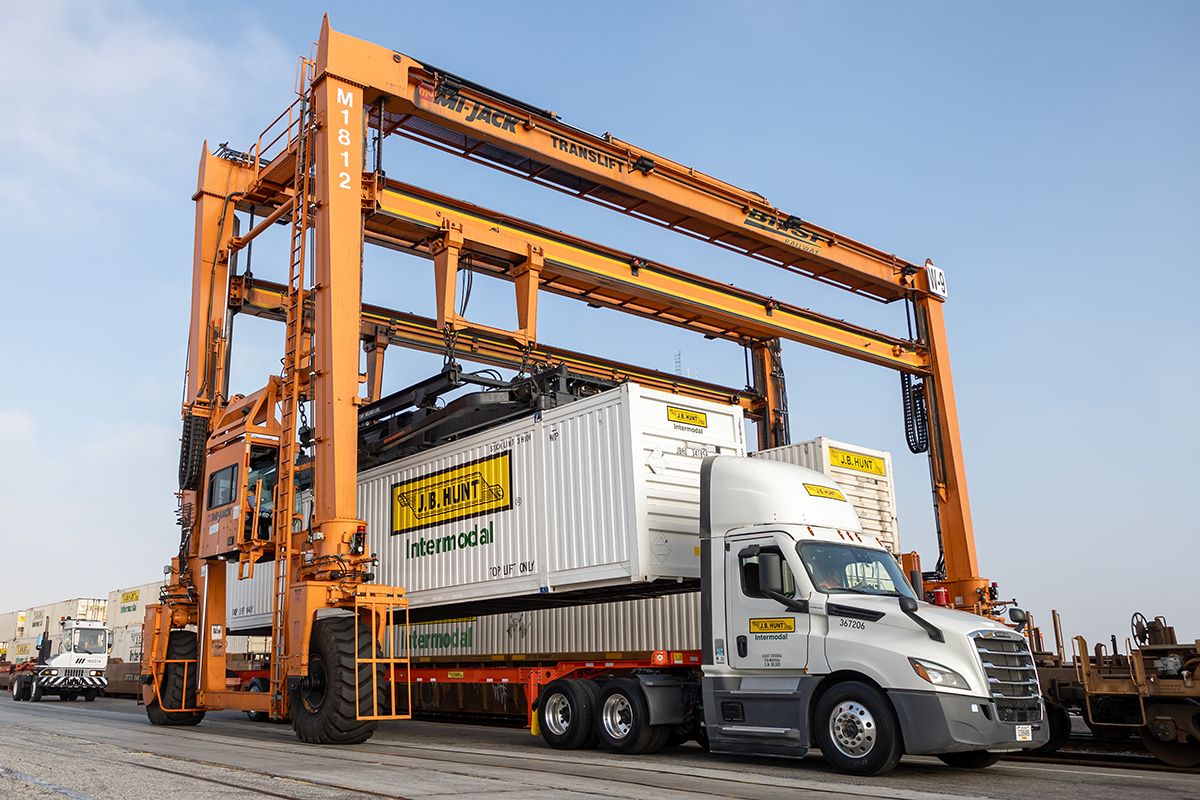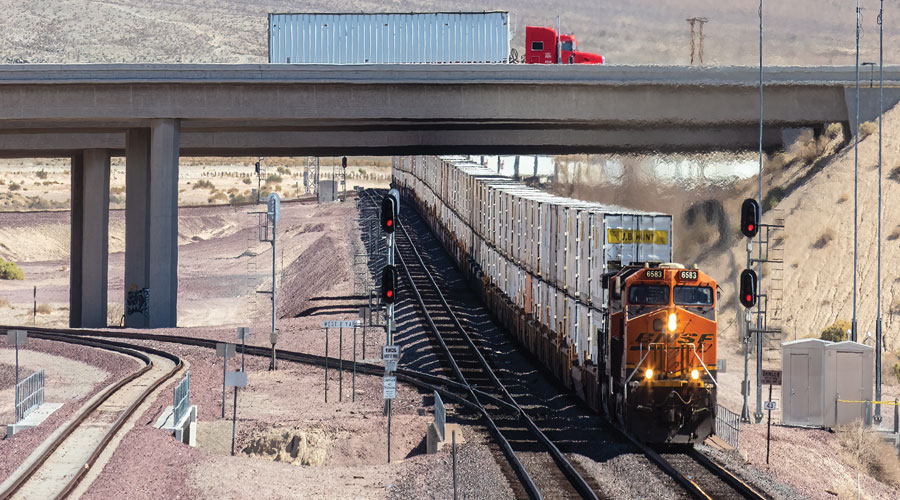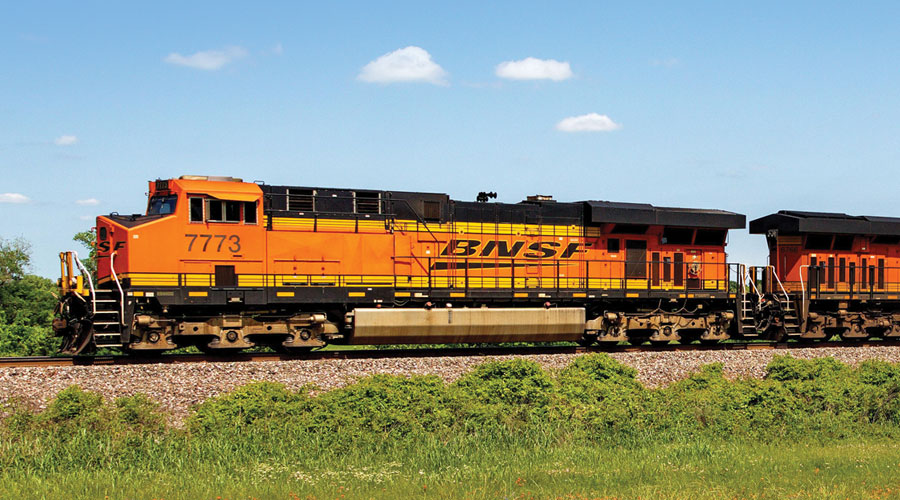Stay updated on news, articles and information for the rail industry
July 2024
Rail News: BNSF Railway
BNSF, J.B. Hunt join forces again to craft an atypical intermodal service tailored for transit time-critical freight

By Jeff Stagl, Managing Editor
In 1989, BNSF Railway Co. and J.B. Hunt Transport Inc. teamed up to do something considered unconventional at the time. They created the U.S. rail industry’s first modern intermodal service.
Fast forward to 2023, and the large Class I and trucking/transportation/logistics giant — who have remained business collaborators for more than three decades — again did something together that’s outside the norm. They crafted a domestic intermodal service that offers the necessary consistency and speed to move service-sensitive freight by rail and priority drayage that typically is transported solely by trucks.
As an acknowledgement of those unorthodox efforts both past and present, the old and new service share the same name: Quantum. Launched by BNSF and J.B. Hunt in November 2023, the new Quantum service is customized to each customer’s needs according to performance expectations, transit requirements and other key factors.
The service promises on-time delivery performance at 95% or better and transit time that’s about a day faster than traditional intermodal offerings. BNSF and J.B. Hunt incorporate priority drayage and rail movements to provide a faster and more consistent transit time.
A Quantum team comprising J.B. Hunt and BNSF operators are housed at an intermodal innovation center at the Class I’s headquarters in Fort Worth, Texas, to monitor every shipment 24/7. Their workflow is integrated at every step of the intermodal shipping process, from planning to execution to exception management.
Quantum targets shippers that often don’t consider rail to move their service-sensitive freight because their supply chains require more consistency and agility than traditional intermodal transportation. Those cargo owners typically are convinced that over-the-road transportation better meets their consistency and timeliness needs.
Quantum offers the cost savings of intermodal and the high level of service and consistency that customers need in their supply chains, BNSF and J.B. Hunt officials say. It isn’t just a different service level for existing intermodal offerings — it’s a true highway-conversion product, they stress.
And since it launched, Quantum is both gaining volume and gaining traction in the marketplace.

There have been many discussions with cargo owners about intermodal’s perceived barriers regarding transit speed and reliability to meet a tight transit schedule, says Tom Williams, BNSF’s group vice president of consumer products, who on Sept. 1 will become executive VP and chief marketing officer. The primary objective with Quantum: to overcome those perceptions.
“A lot of it is cargo that comes out of a plant and is delivered directly to a customer that has tight delivery windows, so the risk of failing that commitment is high. It’s all about managing that risk,” says Williams. “We created a solution that derisks the intermodal service for that.”
Timing isn’t everything
The timing of Quantum’s launch wasn’t exactly ideal — the domestic intermodal market has been soft of late due to abundant truck capacity and low trucking rates. But BNSF and J.B. Hunt executives are convinced they can grow business with Quantum, regardless.
Over the past several years, there have been about 11 million loads that should have been riding on trains but instead were moved only on trucks due to transit-time sensitivity and reliability concerns about rail, says J.B. Hunt EVP of Sales and Marketing Spencer Frazier.
And currently, there are millions of loads of freight that support conversion from truck to intermodal service, J.B. Hunt estimates.

“This goes back to why our companies worked together in the first place: to take highway shipments off the road and put them on the train,” says Frazier. “We think we can leverage that Quantum brand and bring that story back to life, [and] design a product that can be differentiating for our customers.”
For those shippers that are highly anxious about on-time deliveries, Quantum not only has met its 95% performance goal so far, but has exceeded it by averaging about 98%, says Williams.
“One customer, a big Quantum user, recognized their on-time performance from door to door [with Quantum] was superior to over the road,” he says. “There are big opportunities with big companies that segmented what they think is intermodal-feasible and what is not. We are seeing a pipeline of opportunities in front of us start to grow [and] we are seeing momentum.”
The mission now is to maintain that momentum and make more shippers believers in Quantum.
“A big Quantum user recognized their on-time performance from door to door [with Quantum] was superior to over the road.”
— Tom Williams, BNSF
One major advantage in carrying out that mission is the unmatched joint service and capacity of the two service collaborators, BNSF and J.B. Hunt executives say. J.B. Hunt offers a broad range of flexible transportation solutions while BNSF has a high density of volume on its intermodal network.
In most major lanes, the railroad has multiple train departures daily between the Midwest and California. That enables the two companies to manage Quantum traffic differently, says Williams.
For example, a train carrying Quantum freight from Chicago to San Bernardino, California, that misses a cutoff ordinarily might have to wait about 12 hours for the next train to Los Angeles. But understanding that long wait and the implications to tight transit-time windows, a team in San Bernardino can rebuild the train for Quantum and get it headed to Los Angeles. much earlier, says Williams.
Having frequent train departures helps ensure on-time delivery is executed, he says.
There also are things happening behind the scenes that help make Quantum service timely and seamless, says Jon Gabriel, BNSF’s VP of service design and network strategies, who on Sept. 1 will succeed Williams as group VP of consumer products.
Communicate and collaborate
BNSF and J.B. Hunt collaborate both physically and digitally, Gabriel says.
“How we make this happen, it’s unique and hard to replicate. It’s like a service-assurance platform to be more truck-like,” he says.
At the Fort Worth intermodal innovation center, the BNSF and J.B. Hunt operators sit side by side, talking to one another and communicating from cloud to cloud to calibrate in real time, says Gabriel.
The innovation center team aims to quickly detect and resolve issues before they impact a final delivery. The integration of service and technology enables team members to identify variability, expedite shipments and, if necessary, recommend an alternate solution among standard intermodal, expedited intermodal and over-the-road services.
“There’s an optionality to match service with the need of that day. If there is a flat tire or weather event, or something happens at destination, it means we have to accelerate or slow down,” says Gabriel. “There is assurance to someone who was hesitant before to try intermodal.”
The innovation center team members have operating experience, so they can handle a portfolio of customers and make solid decisions about Quantum shipments, says Williams.
“We’ve incorporated AI and machine learning to give us a decision-assist dynamic,” he says. “This enables us to scale up what the team can manage as the volume continues to grow.”
The information-sharing between BNSF and J.B. Hunt is conducted with more precision, which creates agility, says Frazier. There’s a higher level of connectivity, too.
“We work together to build trains systemically and then run our services — the pickup, delivery, and lift and deramp — precisely executing to meet customers’ expectations,” says Frazier.
Gaining from groundwork
Their joint efforts to improve intermodal service efficiency over the past several years helped BNSF and J.B. Hunt lay the groundwork for Quantum. In 2022, they launched a joint initiative to improve capacity in the intermodal marketplace while also meeting customers’ expanding needs, including J.B. Hunt’s plan to grow intermodal capacity to as many as 150,000 containers in the next few years.
In addition, BNSF committed to creating additional capacity at existing intermodal facilities in the near term and establishing a state-of-the-art, master planned rail facility in Southern California — the Barstow International Gateway (BIG) — to better serve the area’s major ports over the long term. The $1.5 billion BIG is projected to open by 2028.
And in June, BNSF announced plans to develop a master planned logistics hub on 4,321 acres in northwest Maricopa County near Phoenix. The hub will feature an intermodal facility on 1,770 acres, a logistics park on 1,420 acres and a logistics center on 1,131 acres.

“Additional capacity gives us additional capability to successfully execute service offerings like Quantum,” BNSF officials say.
Now, BNSF and J.B. Hunt are serving some early Quantum adopters and some recently landed customers. They are poised to attract more shippers that need a more consistent service level to achieve their supply-chain goals and/or a greener transportation option to meet their sustainability objectives, BNSF and J.B. Hunt officials believe.
The two companies conducted some pilot Quantum shipments in summer 2023, during which a few large consumer packaged goods (CPG) shippers showed interest in the service, said Frazier. At launch, some CPG companies partnered with BNSF and J.B. Hunt right out the gate, he says.
The two Quantum collaborators now are holding discussions about the service with other large retail customers while convincing some smaller shippers to become customers.
“The way the current market balances truck competition and good levels of service probably benefited us as we onboarded incremental new customers over the past few months,” says Frazier. “As our core intermodal business is growing, so is Quantum business. And not just big CPGs, but other customers looking at it and saying, what can they do to create a more reliable supply chain at scale and in a new way not done before.”
There are opportunities to bypass typical distribution center-to-distribution center networks by skipping a handling and moving a shipment directly to a customer’s distribution center with a high level of consistency.
For example, a food product shipper uses Quantum to move its freight from points in the Midwest to points in Texas or Northern California, and in reverse from points in Northern California to Texas and the Midwest. The freight — which used to be trucked on highways — is being delivered on time at a very high consistency rate, says Frazier.
“From a [distribution center] to the final destination, customers need that level of consistency,” he says.
Opening doors, exploring lanes
Now, some beverage companies are considering whether to use Quantum in certain lanes. Other shippers are kicking the tires on the service, as well.
“They are asking us to look at different lanes and lane combinations we hadn’t thought of,” says Frazier.
“We will walk or run at the speed of our customers’ confidence.”
— Spencer Frazier, J.B. Hunt
In one case, a retailer that used team shipments off the West Coast converted to Quantum, which put the service to a “real test,” he says.
“We executed flawlessly, and opened some doors inside their longer-term planning,” says Frazier.
What has been and continues to be core to J.B. Hunt’s DNA is conducting customer conversations and seeking to understand their needs, then designing solutions that meet them, he stresses.
“Intermodal is the most efficient way to move freight, with a lower carbon impact — so typically, that conversation goes well,” says Frazier. “We make intermodal easy for those customers, as easy as loading a truckload shipment.”
To make Quantum both easy and attractive, it’s vital to map out the what-if scenarios and create detailed service designs that result in a custom solution. Its potential is great no matter the market conditions as long as the service is highly tailored to each shipper, Frazier believes.
“We know that Quantum has to compete and differentiate in any market. We want to prove the value and at the pace that the customer can accept the change, to get the confidence we can scale quickly,” he says. “We will walk or run at the speed of our customers’ confidence.”
Email questions or comments to jeff.stagl@tradepress.com.


 2025 MOW Spending Report: Passenger-rail programs
2025 MOW Spending Report: Passenger-rail programs
 Gardner steps down as Amtrak CEO
Gardner steps down as Amtrak CEO
 Guest comment: Oliver Wyman’s David Hunt
Guest comment: Oliver Wyman’s David Hunt
 Women of Influence in Rail eBook
Women of Influence in Rail eBook
 railPrime
railPrime






